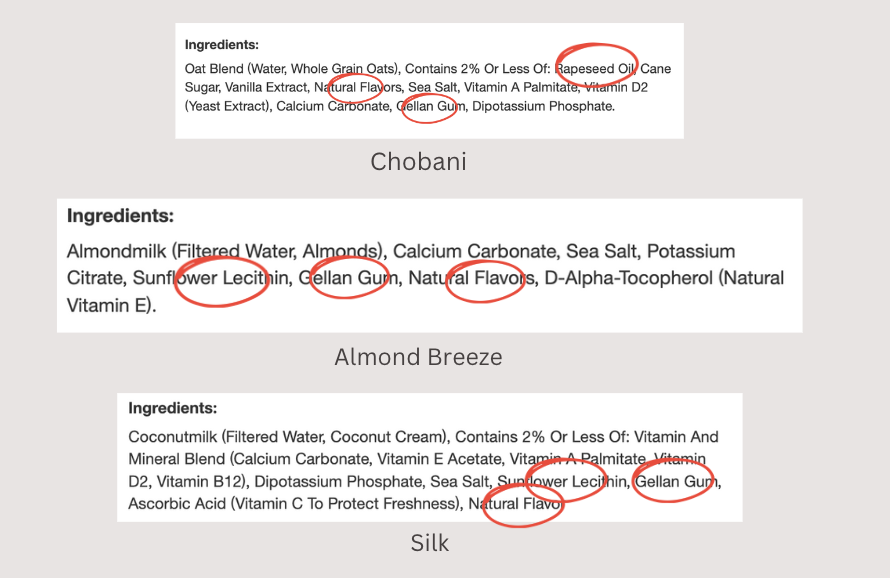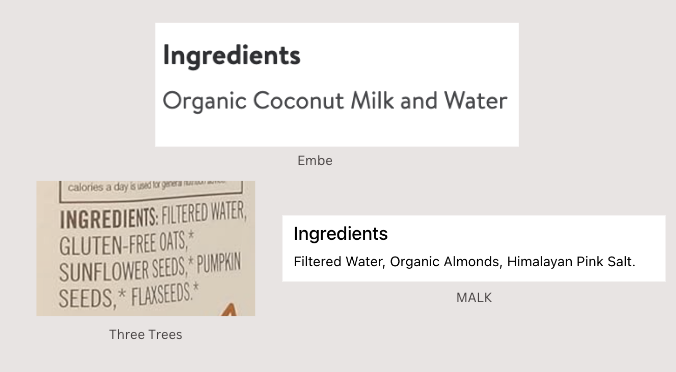What to Avoid
Gums (i.e guar, gellan, xanthan, locust bean gum
Oils (i.e rapeseed oil aka canola oil)
Emulsifiers (sunflower lecithin)
Natural Flavors
Sweetened
“Original” if it’s not also labeled “unsweetened”
Gums: These are used to prevent separation, extend shelf life, and thicken the consistency. Many of these gums have been shown to cause GI issues. Guar gum has been associated with small intestinal and esophagus obstruction (1). Xanthan gum has been associated with laxative effects in adults, and appears to be unsafe and contraindicated for infants (2).
Oils: These are used in order to boost the fat content in plant-based milks (especially oat) so that they don’t have to use as many oats/nuts/etc., in order to bring their costs down. One of the most common oils you will see is low erucic acid rapeseed oil. This is another word for canola oil, which is typically genetically modified and highly inflammatory.
Emulsifiers: One of most common emulsifier you will see in plant-based milk is sunflower lecithin. This is used to help combine the different ingredients together with water. Sunflower lecithin does contain fatty acids, phospholipids, and vitamins, and at times can be used to help balance cholesterol levels, promote absorption of soluble nutrients, and aid in digestion. It can also support breastfeeding mothers. However, excessive lecithin can lead to increased levels of choline, which can overstimulate the nervous system and lead to nausea, diarrhea, vomiting, sweating, headaches, and dizziness.
Natural Flavors: The FDA doesn’t require food labels to disclose what’s in their “natural flavors,” unless the ingredients include a common allergen. When you see “flavor” listed as an ingredient, it is actually a recipe that may be compromised of upwards of 100 ingredients. For example, “natural apple flavor” may have been preserved and stabilized with chemical agents added to help it mix into the product such as propylene glycol, BHT, BHA, and polysorbate 80 (3). However, this isn’t always the case. Sometimes natural flavors may, indeed, be fully natural and non-toxic but the company wishes to not release their “secret ingredient” in order to protect themselves from replicas. So, it’s best to stay away from this ingredient unless you have heard directly from the company and trust their transparency.
Sweetened: This one is pretty self explanatory and means the milk has been sweetened with extra added sugar. The most common flavor you’ll see is vanilla. For example, Almond Breeze’s Vanilla contains 13g of sugar vs 7g in their Original, and 0g in their Unsweetened.
Original: Many people think that “original” means unsweetened or no sugar. This is not the case. Almond Breeze’s Original contains 7g of added sugar, where as their “Unsweetened Original” contains 0g of added sugar.
What to Look For
Simple, plain as possible ingredients.
Safer Options to Consider
Peace, Rice, & Soy
Peace & Rice Milk
Commonly high in heavy metals, especially arsenic. If you choose these milks I would advise reaching out to the company and ask if they have a heavy metal testing process.
Soy Milk
Many studies point towards soy actually helping reduce breast cancer, amongst other benefits. However, there’s also some conflicting research. While I have found more positive than negative research, I typically don’t like to blanket recommend it since it’s benefits potentially depend on each individuals health situation. Soy is also high in Omega-6s, which if over-consuming can lead to inflammation. Also, keep in mind, most soy grown in the US is genetically modified. So if you’re going to choose this milk I would look for one that is labeled “non-GMO” or “Organic.”
Sources:
1 Lewis JH. Esophageal and small bowel obstruction from guar gum-containing "diet pills": analysis of 26 cases reported to the Food and Drug Administration. Am J Gastroenterol. 1992 Oct;87(10):1424-8. PMID: 1329494.
2 Daly J, Tomlin J, Read NW. The effect of feeding xanthan gum on colonic function in man: correlation with in vitro determinants of bacterial breakdown. British Journal of Nutrition. 1993;69(3):897-902. doi:10.1079/BJN19930089










Comments